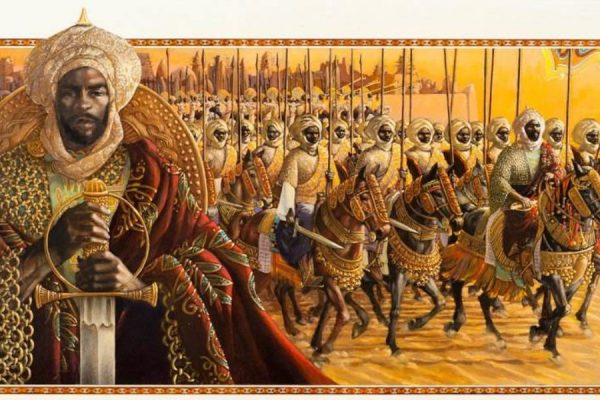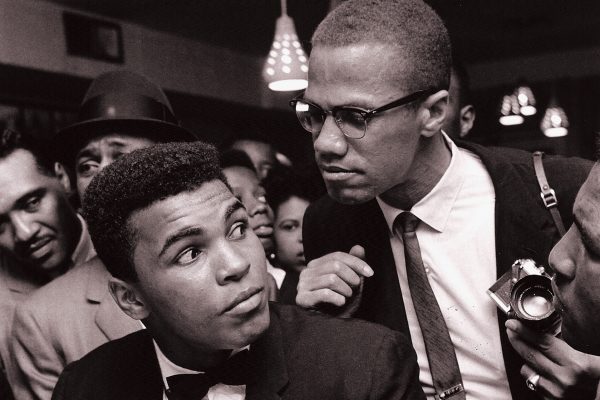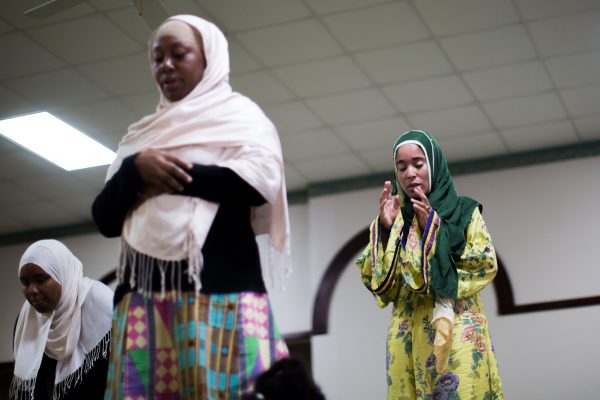The freedom of black peoples in the Americas has likewise been the historical condition for the free and full practice of Islam in this hemisphere. This history can be the basis for meaningful solidarity going forward — one to which our Black Muslim hero has always pointed us.
The freedom of black peoples in the Americas has likewise been the historical condition for the free and full practice of Islam in this hemisphere. This history can be the basis for meaningful solidarity going forward — one to which our Black Muslim hero has always pointed us.
We are still grappling with the life and legacy of Malcolm X now more than fifty years after his martyrdom in the Audubon Ballroom. His lived example ironically inspired both the formation of the Black Panther Party and the Nation of Islam’s gradual move away from black nationalism. Spike Lee canonized him as a black hero in his 1992 film, Malcolm X, and he was referenced at Barack Obama’s 2009 inauguration as a dangerous, militant foil to a sanitized, pacifist rendering of Dr. Martin Luther King, Jr..1
He has been both the quintessential black revolutionary for Marxists and a paragon of “post-Hajj” Islamic orthodoxy for many Muslims. Many have attempted to stake a claim in (or denounce) the multitudes that he contained so effortlessly.
Yet Malcolm-the-Black-Hero and Malcolm-the-Muslim seem rarely to meet each other in contemporary discourse — despite their emergence from a man for whom these identities walked hand-in-hand. How, then, are we to understand his legacy at a time when a prominent face of American Islam has spoken out against the movement for Black Lives even as calls for solidarity between Muslims and communities of color in the age of Trump are invoking his name anew?2
Ta-Nehisi Coates’ most recent book, Between the World and Me, provides an excellent place to begin a fresh encounter with Malcolm X. Coates writes the book as a letter to his son, discussing the realities of race and racism he will need to navigate growing up in the United States.
Malcolm makes an early appearance here as a formative voice for Coates’ own development as a young black man coming up in Baltimore during the eighties and nineties. This was a time, he explains, in which the “air… was charged with a call for a return, to old things, to something essential, some part of us that had been left behind in the mad dash out of the past and into America.” Malcolm’s voice emerged clearest among these calls, sampled alongside bass lines and drum beats during the early days of hip hop.
I loved Malcolm because Malcolm never lied, unlike the schools and their façade of morality, unlike the streets and their bravado, unlike the world of dreamers. I loved him because he made it plain, never mystical or esoteric, because his science was not rooted in the actions of spooks and mystery gods but in the work of the physical world.”
Malcolm recalled a form of blackness that was essential and pure — molded but not ravaged by centuries of enslavement and racial terror. Importantly, for Coates, this also implied a form of blackness untainted by the Christianity that he himself never knew. Malcolm X was someone who “would not turn the other cheek for you…. Malcolm spoke like a man who was free, like a black man above the laws that proscribed our imagination.”
Coates prized Malcolm as a paragon of blackness who was unapologetic, driven by forces unseen, yet thoroughly rooted in this physical world: “he returned [from prison] wielding some old power that made him speak as though his body were his own. ‘If you’re black, you were born in jail,’ Malcolm said…. Perhaps I too might wield the same old power that animated the ancestors.”3
Coates’ describes a Malcolm thoroughly cast in the die of a Marxist revolutionary. He is a black hero precisely because he cuts through racist and religious obfuscation to the underlying material conditions of white supremacy.
Yet this description simultaneously captures the complexity of a man whose revolutionary spirit and commitment to justice for black Americans is fully constituted by his Islam. The author’s use of “spooks and mystery gods” to characterize the forces Malcolm fought with his “science” directly quotes Elijah Muhammad’s polemics against Christian theism in favor of Islam as a “natural religion of the black man.”4
Islam was also, of course, that “old power” with which Malcolm returned from prison — just as it undoubtedly animated countless ancestors before and after “the mad dash out of the past and into America.”5 Despite Coates’ own avowed atheism, he cannot seem to praise Malcolm as a black hero without subtly invoking his Islam. For as he faithfully demonstrates, Islam is the black power that animated Malcolm X and his continued legacy.
Between the World and Me provokes us to ponder the full complexity of Malcolm X by thinking about the history that produced him. His power was an “old” one because the potent relationship between Islam and black peoples in the Americas long preceded him. But what is this historical relationship and how are we to think about it? Here, too, Coates provides valuable insight.
Toward the end of the book, he speaks directly to his son about his ancestors and the struggle he inherits from them. “The Struggle is in your name, Samori — you were named for Samori Touré, who struggled against French colonizers for the right to his own black body.” This is, of course, the same Samori Touré who ruled the independent Muslim empire of Wassoulou in what is now Guinea; his aptly-named “struggle” was in fact a jihad against the French that he inherited from al-Hajj Umar Tal and a lineage of anticolonial mujahideen before him. That “old power” that Coates admires in Malcolm X is thus a tradition of African Muslim struggle that extends across the Atlantic — informing new struggles that we still fight today.6
What Coates can point us toward is in fact a new understanding of the history of Islam in the Americas through a fuller account of Malcolm X. The presence of significant numbers of African Muslims enslaved in the Americas is now an established historical fact.7 Historical research over the past few decades has revealed as many as 30% of the Africans enslaved in the United States were Muslims — and that this accounts for only a fraction of the total Muslims stolen from Africa over the course of the Atlantic Slave Trade.8
Historians have, so far, written African Muslims into existing narratives about black enslavement — a natural choice reflecting the very real evidence of Muslims on plantations throughout the Americas. Yet this is not the full story. The line running from Samori Touré to Malcolm X, two Muslim revolutionaries unbent by colonialist racial terror, certainly does not seem to run through the plantation.
Indeed, there is ample evidence to suggest that the tradition of African Islam running between them has been transmitted through free communities of Muslims living and engaged in anti-colonial struggle in the Americas for centuries. The “Free Mandingoes” of Trinidad, the Malê Revolt of Bahia, and Fort Musa in Florida are just a few such examples.9 While the history of enslavement is therefore necessary to tell the full story of Islam in the Americas, it is certainly not sufficient; free African Muslims fighting colonial subordination have been integral to the struggle for black self-determination that Malcolm X and his protégés inherited.
The two Malcolms mentioned above must begin to meet more often in our memories of him. He has been a hero to black revolutionaries and Muslims alike for half a century now because Islam has always been integral to the structure of what Cedric Robinson calls the “Black Radical Tradition” — that “specifically African response to an oppression emergent from the immediate determinants of European development in the modern era and framed by orders of human exploitation.”
The freedom of black peoples in the Americas has likewise been the historical condition for the free and full practice of Islam in this hemisphere. This history can be the basis for meaningful solidarity going forward — one to which our Black Muslim hero has always pointed us.
This article was originally published on Sapelo Square, found here.
- Sohail Daulatzai, Black Star, Crescent Moon: The Muslim International and Black Freedom Beyond America (Minneapolis: University of Minnesota Press, 2012), ix-x. ↩︎
- Sheikh Hamza Yusuf recently stoked controversy as the RIS 2016 conference by claiming that the United States is “one of the least racist societies in the world,” defending police who commit violence against minorities, and broadly dismissing anti-racist movements like Black Lives Matter. ↩︎
- Ta-Nehisi Coates, Between the World and Me (New York: Spiegel & Grau, 2015), 36-37. ↩︎
- See the first chapters of Message to the Blackman, entitled “Who Is That Mystery God?” which answers, “some invisible spook somewhere in space.” Elijah Muhammad, Message to the Blackman in America (Phoenix, AZ: Secretarius MEMPS Publications, 1973), 4-5. The original teachings attributed to Fard Muhammad, Teaching for the Lost-Found Nation of Islam in a Mathematical Way, uses the same language. ↩︎
- Malcolm’s conversion in prison is detailed in The Autobiography of Malcolm X. ↩︎
- Coates, Between the World and Me, 68. ↩︎
- See, for example, Allan Austin’s African Muslims in Antebellum America or Sylviane Diouf’s Servants of Allah. ↩︎
- Henry Louis Gates, Jr., “How Many Slaves Landed in the US?” The Root, January 6, 2014, accessed October 16, 2016, http://www.theroot.com/articles/history/2014/01/how_many_slaves_came_to_america_fact_vs_fiction/. ↩︎
- See respectively: Carl Campbell, “John Mohammed Bath and the Free Mandingos of Trinidad”; Joao Jose Reis, Slave Resistance in Brazil: Bahia, 1807-1835; Samory Rashid, Black Muslims in the U.S. ↩︎





